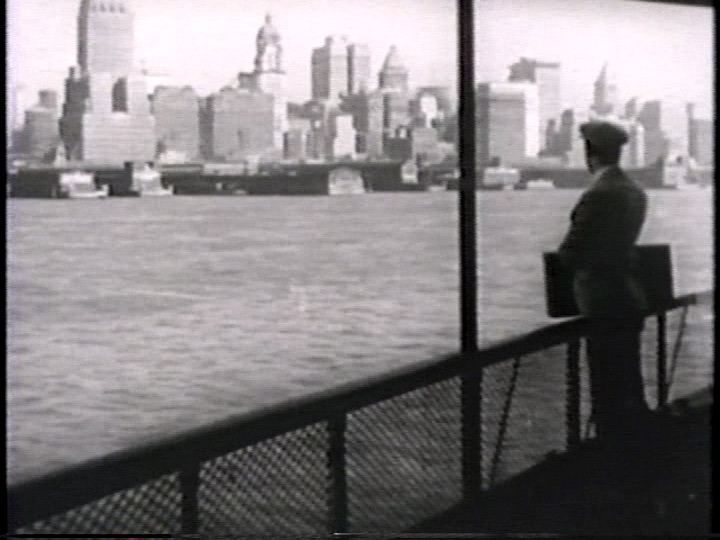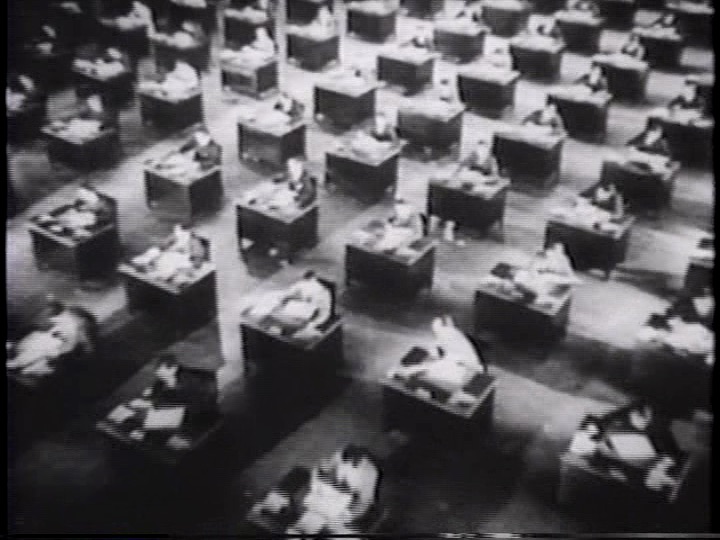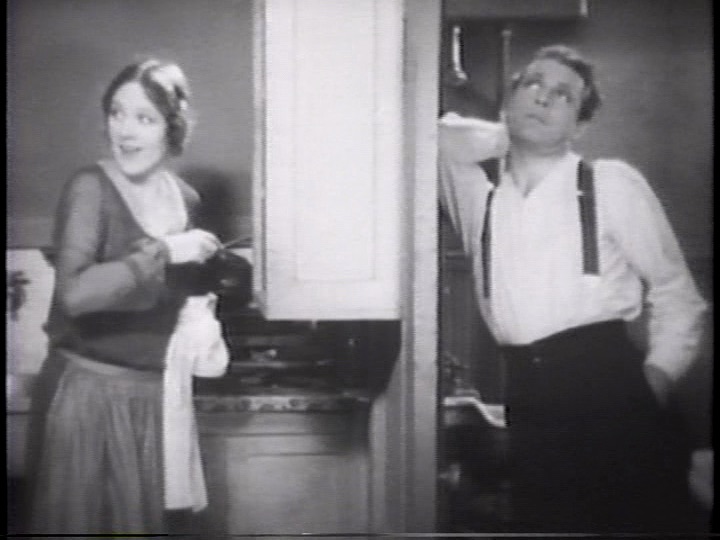Teaching The Crowd
Joshua Glick
In the opening sequence of King Vidor’s The Crowd (1928), twenty-one-year old John Sims (played by then-unknown actor James Murray) encounters the New York City skyline from the deck of a steamship.
It’s 1921, and John is embarking on what he believes will be a highly successful career in the Big Apple. We look over his shoulder as he leans out over the railing and takes in the expansive array of skyscrapers, including the Barclay-Vesey Building, the Singer Building, and the Bankers Trust Company Tower. When I show this film in class, my students, many of whom have never been to New York, are as captivated and energized as the young protagonist on screen. However, the unsolicited advice offered by a sullen, stooped-shouldered fellow passenger – “You’ve gotta be good in that town if you want to beat the crowd” – disrupts the buoyant mood. This early scene conveys the optimism and excitement that New York City inspires in John, yet also, more soberly, portends that distinguishing himself from the millions in the metropolis might be arduous if not impossible.
I teach The Crowd in my Cinema and American History seminar at Hendrix College, a liberal arts college near Little Rock, Arkansas. The course explores the ways in which cinema has depicted major events and changes in US history, as well as cinema’s central yet ever-shifting place within American culture. We begin with the emergence of projected motion pictures in the late nineteenth century and continue to our contemporary moment. For our unit on the 1920s, we examine The Crowd through the optic of “place.” This approach draws on scholars John David Rhodes and Elena Gorfinkel’s concept of films “taking place,” constructing and preserving particular social locations in the world.[1] I ask students to consider how Vidor and crew create New York at a time when representing the “reel” New York often involved a skillful mix of on-location shooting, use of stock footage, and in-studio design. How does Vidor orient us to and in the metropolis, framing how we think about the city, and what does his depiction reveal about interwar America? As Vidor reminds us in his autobiography, A Tree is a Tree (1953), The Crowd is at once about New York specifically but also any “great city anywhere.”[2]
Our session on The Crowd toggles between a specific reading of the film and a general cultural-historical investigation of the period. Students come to understand how the cinematic New York in The Crowd is not the simply found or passively observed city. They also learn the ways films interpret places within historical epochs. I ground our discussion in a series of early scenes that portray three distinct locales: the office, the amusement park, and the domestic interior. Our analysis of these scenes, with help from primary documents and secondary sources, serves as a springboard for a broader conversation about John and his family in the narrative that follows, and spotlights how the film articulates aspirations and harsh realities that characterize the experience of modernity.
Our first scene depicts John’s professional routine. It begins with a montage of perspectives showing various forms of traffic. I ask students: what forms of circulation do we see? Pedestrians move briskly along sidewalks on W. 45th Street, trains whiz by on elevated rails in Herald Square, double-decker buses crisscross wide thoroughfares. It is fitting that the car receives a spotlight, as Henry Ford helped make automobiles a ubiquitous fixture of the urban landscape during the decade. An advertisement I show from a February 1925 Ladies Home Journal announces that these machines possess the power to “Cancel Distance and Conquer Weather.”[4] Some shots in The Crowd feature an on-the-ground perspective, made possible by Vidor’s “pushcart perambulator:” a cart carrying “hollowed-out boxes” that concealed a cameraman, which was steadily wheeled from the Bowery to Times Square.[5] We note how these perspectives recall the turn-of-the century single-shot films that we saw earlier in the course and succeed in conjuring a sense of the dynamic pace of life in the booming city.[6]
Settling at the base of the Equitable Life Building, looking upward at the imposing structure, The Crowd moves from the street to the interior – from on-location shooting to a studio setting and from a lively and sensory-rich atmosphere to one that is far more confining and dull. Vidor and cameraman Henry Sharp simulate our assent up the facade by way of a cinematic trick: they rigged a camera to glide across a model of the building laid horizontally on a studio floor. We then enter through what appears to be a window on the twentieth floor and move across a wide expanse of desks in the Atlas Insurance Company. The office’s open floor plan provides an opportunity to discuss the social meaning of mise-en-scène: how does the organization of this room signify John’s status within the company, as well as broader characteristics of white collar work? [7]
While John has managed to secure employment in finance, his job has not afforded him the opportunity to distinguish himself. The array of meticulously arranged desks, each identical to the other, makes him seem like a cog in a machine, performing a prescribed set of tasks. During a decade when Republican administrations championed the dignity of big business and its importance to the American economy, John demonstrates how grueling life can be within a corporate hierarchy. Cinema and media studies scholar Miriam Hansen helps us to see how “geometrical patterns of sameness” and the corresponding “repetition” of actions on display within the open floor plan suggest that John is part of a white-collar factory system, under the influence of both Taylorized time-management and the Fordist assembly line. He is both producing a product and is a product himself, and the plaque atop his desk identifying him as a number (“137”) further diminishes his humanity.[8] The close-up of the clock, placed for all employees to see, foregrounds one of the central emblems of control within this setting. The clock striking “five o’clock” marks the close of the workday, propelling the relieved and exhausted personnel out of the office.
In partial contrast to the depiction of the deadening effects of corporate modernity, our second scene presents students with the possibilities and constraints of a mechanized mass culture.[9] John, his coworker and friend Bert (Bert Roach), and their respective dates Mary (Eleanor Boardman) and Jane (Estelle Clark) go for a night out to Coney Island. Electricity (rather than steam) powers the evening’s entertainment, illuminating the facades of Luna Park and fueling the rides.[10] I bring in supplementary photographs from the period to clarify the exact site of production, reminding students that practical constraints such as budget and time often shaped film practice. While the establishing shots were indeed taken in Southern Brooklyn, the interiors of the Fun House were shot at Venice Pier in Los Angeles, what was referred to by journalists at the time as the “Coney Island of the Pacific.”[11]
The Alpine Racing Slide and the Spinning Society Wheel display the transgressive pleasures of close contact that made Coney Island attractive to young working men and women. And yet, as cultural historian Lauren Rabinovitz notes, the Coney Island experience is here ultimately a streamlined process of restrictive heteronormative coupling.[12] Social cues on rides such as the Tunnel of Love, along with signs plastered along the interior of the subway, transform John and Mary from strangers to intimates to an engaged couple. John enjoys thinking of advertising slogans (both in his free time and on the job); still, his encounter with the advertisement for the Jackson Stefnell Furniture Company places both he and Mary on the receiving end of the message: “You Furnish the Girl, We’ll Furnish the Home!” The flashy image of domestic life that at once objectifies Mary and places materiality at the center of marital bliss persuades John to propose.
Our third and final scene takes us to the heart and hearth of American life. Immediately after John and Mary’s honeymoon to Niagara Falls, we find ourselves in their newly inhabited tenement apartment. Their home is in one sense a refuge from the workaday world of the city.
Again, my students begin by taking inventory of all they see. What comprises the home? A Murphy bed, which by the 1920s was a major trend; a full-service kitchen in which an oven-cooked roast can be made; indoor plumbing and electric lighting; and a living-room nook and dining room adorned with artwork on the walls where they can host guests. It is, in sum, a comfortable and modern domestic interior. But the bustling, machine-made world nonetheless intrudes. The abrasive sounds of the train waft in through the window, serving as an unwelcome soundtrack to their lives. Doors are supposed to compartmentalize the space, making it more versatile. However, they never stay shut, and when they do, they become hindrances. What was imagined as a place of tranquility is characterized by disquiet; Mary works hard to cook, clean, and prepare the house for guests, while John lethargically plays his ukulele and laments the street noise. This unsettled and unsettling atmosphere anticipates the anxious encounter between John and Mary’s family, who express extreme displeasure with his stagnant job and poor prospects for a raise.
By addressing what at first glance appears to be backdrop, as in fact critical to the narrative, my students learn to recognize the importance of “place” as contributing to the themes of the film. The drama of John’s attempts (or lack thereof) to separate himself and his family from “the crowd” is experienced in terms of distinct locations within the metropolis. These places are crucial to our understanding of the life-worlds of the characters. Opening up the discussion, we explore how these three places surface later in the film. Students mention how Vidor portrays the fracturing of their marriage through the deterioration of their apartment. Additionally, they mention that sites including “the street” at first constitute a place of play and productivity, but later become the very opposite, as a commercial truck becomes the vehicle of death that kills John and Mary’s daughter.
At the end of class, we turn our attention to the final scene, which occurs at a vaudeville show in a large theater. I at first invite the students to interpret this scene as hopeful, since it ostensibly presents John and Mary as reconciled, their relationship strengthened by the exuberant experience of the comedic display. It is a moment of collective enjoyment that offers them a reprieve from the daily grind. But as students are quick to note, it can readily be viewed as showcasing the couple’s ultimate absorption into the crowd, participating in a form of mass distraction that yields the audience incapacitated and speechless. Yes, John and Mary are back together and some form of economic stability might be possible. But can they achieve a heightened status beyond the “crowd?” Citing John’s past actions, and the broader context of socioeconomic forces that shaped his and his family’s life in New York, most students are doubtful.
This final scene, then, creates the opportunity to speculate about the persistence of The Crowd’s logic in our yet more fully technologized time. Do students consider themselves to be part of “the crowd?” They proclaim their individuality and declare that they are at the very least critical consumers of entertainment, possessing a more discriminating eye than John and the rest of the audience members. At the same time, the question opens up a space for students to reflect on their viewing habits with one another, sharing how they watch different kinds of media individually and collectively.
If we are to see the forms of amusement in The Crowd (the slapstick clowning in the theater, the Coney Island rides, phonograph records) as keeping people momentarily satiated, but ultimately part of an easily manipulated mass of consumers, how are we to interpret the place of cinema during the 1920s, or our own time for that matter? This question provokes students to think about how moving pictures have long been a big business of their own and an integral part of the modern media landscape. We also discuss how Vidor, like directors today, see cinema (and cultural forms more generally) as possessing a power to comment on and critique the social environments they depict.[13] This criticism-and-complicity dialectic in turn sets up a host of related, philosophical, and relevant conversations that we will take up in our next unit on “Cinema in the Shadow of the Great Depression,” and encourages them to continue to think about the role that cinema plays in their lives.
Joshua Glick is Assistant Professor of English and Film Studies at Hendrix College. He holds a PhD from Yale University in Film & Media Studies and American Studies. His research and teaching interests are focused on global documentary film, television, and web-based media, race and popular culture, broadcast communications, and American social history. His articles have appeared in Film History, The Moving Image, and the Historical Journal of Film, Radio and Television. Joshua recently completed a series of catalog essays and a documentary for the traveling museum exhibition, Coney Island: Visions of an American Dreamland, 1861-2008. His book, Los Angeles Documentary and the Production of Public History, 1958–1977, is forthcoming from the University of California Press.
Notes
[1] John David Rhodes and Elena Gorfinkel, “Introduction,” in Taking Place: Location and the Moving Image, ed. John David Rhodes and Elena Gorfinkel (Minneapolis: University of Minnesota Press, 2011), vii-xi. For more about the cinema-city intersection with a focus on New York, see, for example, Kathy Peiss, Cheap Amusements: Working Women and Leisure in Turn-of-the-Century New York (Philadelphia: Temple, 1986); Sabine Haenni, The Immigrant Scene: Ethnic Amusements in New York: 1880-1920 (Minneapolis: University of Minnesota Press, 2008); Merrill Schleier, Skyscraper Cinema: Architecture and Gender in American Film (Minneapolis: University of Minnesota Press, 2008); James Sanders, Celluloid Skyline: New York and the Movies (New York: Alfred A. Knopf, 2002); Richard Koszarski, Hollywood on the Hudson: Film and Television in New York from Griffith to Sarnoff (New Brunswick: Rutgers University Press, 2008); Mark Shiel and Tony Fitzmaurice, eds. Screening the City (London: Verso, 2003).
[2] King Vidor, quoted in “King Vidor Discusses Motion Pictures – His New Film is Built Like a Play,” New York Times, May 22, 1927, X5. In 1920, one year before John sets sail for New York, the Census reported that, for the first time, more than fifty percent of people in the U.S. lived in “urban” rather than “rural” environments. “Urban and Rural Areas,” United States Census Bureau, accessed online October 20, 2017: https://www.census.gov/history/www/programs/geography/urban_and_rural_areas.html
[4] Advertisement, Ladies Home Journal, February 1925, 66.
[5] King Vidor, A Tree is a Tree (New York: Harcourt, Brace and Company, 1953), 152.
[6] Construction of office space in New York increased by ninety-two percent during the latter half of the 1920s. For more on New York City’s building boom and its status as an industrial powerhouse, see Robert A.M. Stern et. al. New York: 1930: Architecture and Urbanism Between the Two World Wars (New York: Rizzoli, 1987), 507-49.
[7] Vidor, A Tree is a Tree, 151; King Vidor, interviewed by Nancy Dowd and David Shepard, (Metuchen, NJ: The Directors Guild of America and Scarecrow Press, Inc., 1988), 79-88.
[8] For more on the relationship between The Crowd, critical theory, and Siegfried Kracauer’s concept of the “Mass Ornament,” see Miriam Hansen, “Ambivalences of the ‘Mass Ornament:’ King Vidor’s The Crowd,” Qui Parle 5, no. 2 (Spring/Summer 1992): 102-19.
[9] For a cultural historical overview of films of the era that is good for undergraduate teaching, see Robert Sklar, Movie-Made America: A Cultural History of American Movies (New York: Vintage, 1975), 86-121; Angela Dalle Vacche, “1928: Movies, Social Conformity, and Imminent Traumas,” in American Cinema of the 1920s: Themes and Variation, ed. Lucy Fischer (New Brunswick: Rutgers, 2009), 211-23.
[10] Lucy Fischer, “Introduction: Movies and the 1920s,” in American Cinema of the 1920s, 4-5. An expanded mass transit system made Coney Island more accessible post-WWI.
[11] In such films as It (Clarence Badger, 1927) and Lonesome (Paul Fejös, 1928), Venice or Santa Monica would frequently serve as practical stand-ins for this Southern Brooklyn amusement destination. Jeffrey Stanton, Venice California: ‘Coney Island of the Pacific’ (Donahue: Los Angeles, 1987), 134-200. For more about on-location shooting and the production history of The Crowd, see Jordan Young, King Vidor’s The Crowd: The Making of a Silent Classic (San Bernardino: Past Times Publishing, 2014). Also, see essays by Charles Musser and Joshua Glick in Coney Island: Visions of An American Dreamland, 1861-2008, ed. Robin Jaffee Frank (Hartford: Wadsworth Atheneum Museum of Art, 2015).
[12] Lauren Rabinovitz, Electric Dreamland: Amusement Parks, Movies, and American Modernity (New York: Columbia University Press, 2012), 154-61.
[13] Critics at the time of The Crowd’s release often discussed the film in terms of its social resonance. See, for example, Norbert Lusk, “Crowd’ Piece of Rare Skill,” Los Angeles Times, February 26, 1928, C13, C23; N.B.B. “Columbia,” Washington Post, April 9, 1928, 16.




